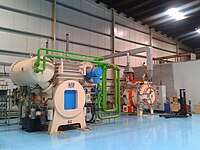
Photo from wikipedia
Abstract Plasma cladding has been widely applied in surface modification and repairing. In this study, the NiCrBSi coating was prepared on gray cast iron by plasma cladding. Scanning electron microscopy… Click to show full abstract
Abstract Plasma cladding has been widely applied in surface modification and repairing. In this study, the NiCrBSi coating was prepared on gray cast iron by plasma cladding. Scanning electron microscopy (SEM), energy dispersive microanalysis (EDS), X-ray diffraction (XRD) and transmission electron microscope (TEM) were used to identify the microstructure and phase types of the cladded layer, the bonding zone and the heat affected zone. The microhardness, elastic modulus, tensile performance and wear performance of the cladded layer were analyzed by the microhardness tester, nanoindentation, tensile test and wear test. The results show that typical microstructure of the cladded layer is dendrites of γ-(Fe, Ni), with interdendritic phases rich in B(Fe, Si)3, Cr15.58Fe7.4C6 and Cr7C3. The bonding zone mainly consists of martensite, retained austenite, graphite, pearlite and a small amount of carbide network, while the heat affected zone is mainly a mixed microstructure of martensite, retained austenite and graphite. The Ni-based coating presents a significantly superior microhardness, elastic modulus and tensile strength and wear performance resistance than those of the gray cast iron. In addition, elastic modulus test and tensile test show that the interface between the cladded layer and the substrate has good metallurgical bonding characteristics.
Journal Title: Surface and Coatings Technology
Year Published: 2019
Link to full text (if available)
Share on Social Media: Sign Up to like & get
recommendations!